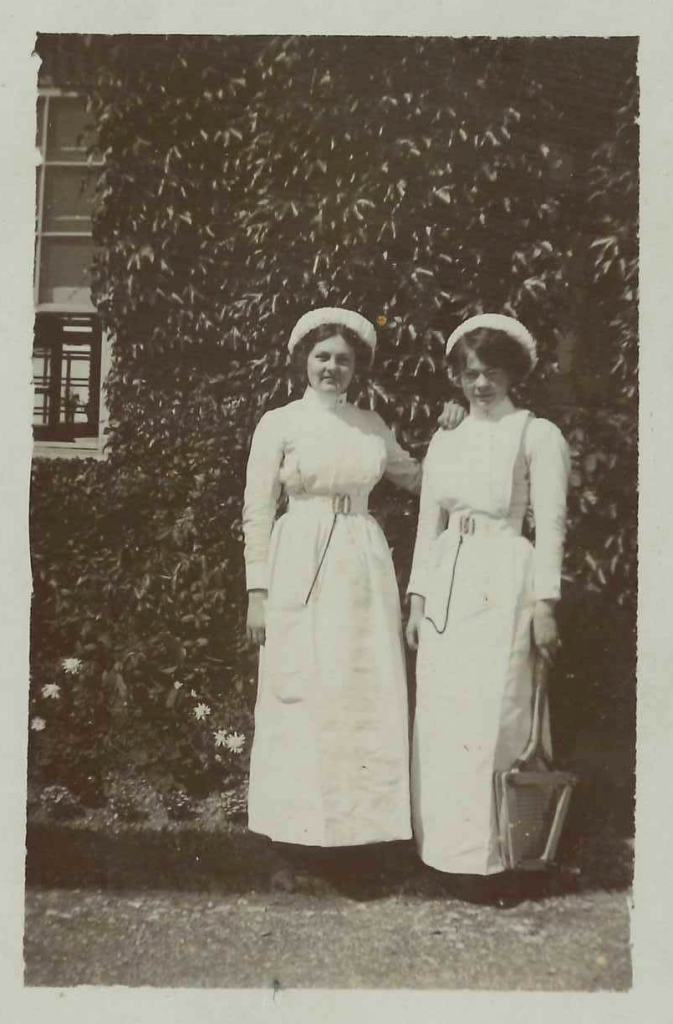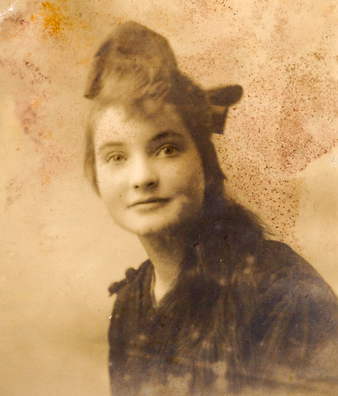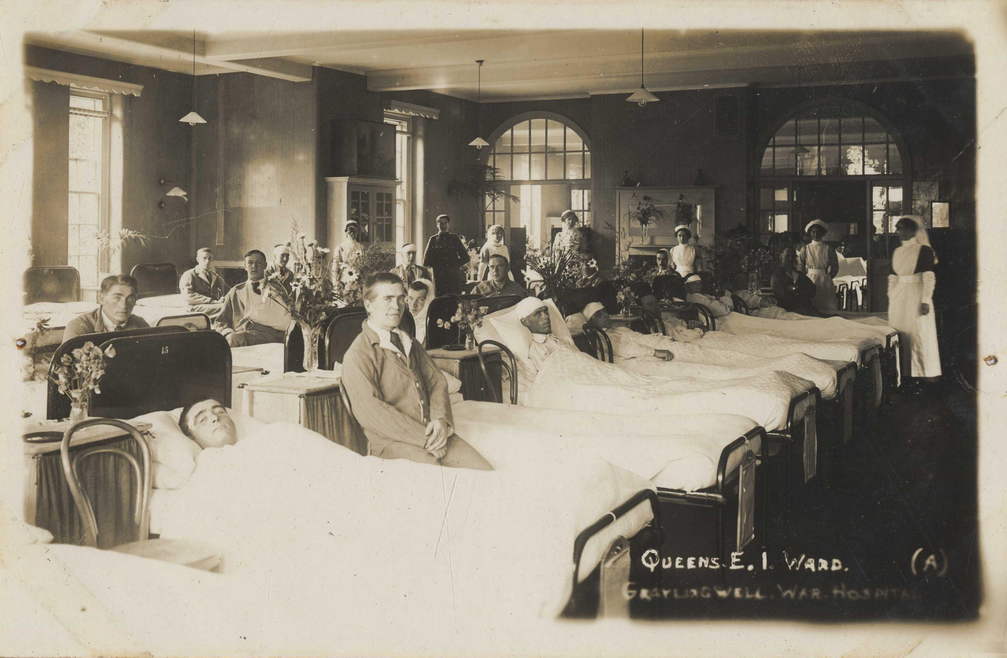Arguably, the profession of nursing offered the same essential experience for every nurse. Yet, it was the experiences born from a specific place and time which gave each nurse their own unique story, and West Sussex has been home to a number of historically significant institutions. From the medieval hospitality of St Mary’s Hospital in Chichester to the state-of-the-art treatments developed at the Queen Victoria Hospital in East Grinstead, each presented their own challenges. Nurses themselves came with a variety of backgrounds. The young and working class may have began their careers in psychiatric treatment at Graylingwell Hospital. In contrast, middle and upper class women were often those who became VAD nurses, working outside a traditional hospital environment.
Read on for a whistle-stop tour of the history of nursing in West Sussex through archival records.

Nursing on film

Snippet from the Nursing film on Vimeo by Screen Archive South East, part of the series for West Sussex Unwrapped.
Images should not be reproduced without permission from West Sussex Record Office.
St Mary’s Hospital, Chichester, 13th century

PH 15550-76 
PH 15907-114
St Mary’s Hospital in Chichester was established in the early 13th century, the very beginning of the Plantagenet era – and quite possibly under Henry II. Medieval hospitals couldn’t be more dissimilar than those of today. Most offered only rudimentary nursing. They provided the elderly and infirm with a place for recuperation through ‘hospitality’, rather than medical treatment. By the 16th century, St Mary’s functioned as almshouses for permanent residents, as it still does today.
You can read more about the hospital on Chichester Cathedral’s website.

On the whole, the further we go back in time the trickier it is to locate relevant records. Recordkeeping has developed a good deal over the last few hundred years, and finding records relating to a medieval hospital is not easy. Specialist knowledge is often needed to interpret them. Nevertheless, we hold a number of records connected to the hospital, including 12 membranes (sheets of parchment or vellum) for the manor of the ‘Hospital of the Blessed Mary in the City of Chichester’ dated 1691-1907 – reference Cap 4/7/1.
There are other papers of the Hospital here, dated 1792-1897, which include manor court papers – series reference Cap 4/3. However, and not unusually, relatively little has survived during the Hospital’s 800 years of existence and nothing explicit prior to the 1600’s.
AM 1041 – Papers of Emily and Francis Lloyd

Emily in her nursing uniform, AM 1041/1/2/1 
Francis in military uniform, AM 1041/1/1/2

Emily Lloyd (nee Caiger) was born in Chichester in 1896. On the 1911 census, Emily is recorded as being a “mother’s help”, i.e. that she worked in childcare. She joined the staff of Graylingwell Hospital in October 1914 as an under housemaid. She continued on the staff throughout World War One and in August 1919 she started work as a probationer nurse.
She went on to marry Francis James Lloyd, also a nurse at Graylingwell, in 1921. Francis served in WWI as a sergeant in the London Rifle Brigade and received commendation for his good service. After the war, he returned to Graylingwell, again as a nurse, until his retirement in around 1946.
Emily left nursing after her marriage, but when WWII came around she joined the Chichester women’s division of St John’s Ambulance service.
Photograph of Emily with a nursing colleague, AM 1041/1/2/2.

Graylingwell Hospital, Chichester, est. 1897

The Sussex County Asylum (St. Francis Hospital) in Haywards Heath, which opened in 1859, was the primary hospital for mental health patients in West Sussex. However, after thirty years it was struggling to cope with increasing demand, and Graylingwell Hospital was opened in 1897.
Only 17 years into its operation, Graylingwell was requisitioned as a temporary military hospital during World War One. It was a modern and well-equipped institution, which resulted in the hospital playing a significant role in the recuperation of the British Army.
Margaret Tully, originally from Ireland, (pictured below) was one of thousands of young women whose first foray into the world of work was as a psychiatric nurse. She applied to Graylingwell in 1919, at a time when the hospital was just returning to its usual practice of mental health treatment, and hers is just one of six applications to have survived. Margaret may not have been aware of the especially challenging nature of nursing in an asylum environment as she left only a month later. It was, indeed, a career that required an unusual amount of skill, patience, and understanding.

Margaret Tully aged 17, 1917. 
Margaret Tully’s Graylingwell application form, 1919
Add Mss 45230 – Autograph book of Evelyn Palmer at Bignor Park

Voluntary Aid Detachment (VAD) nurse, Evelyn Palmer, kept an autograph book of messages from servicemen and a number of photographs of her time working at Bignor Park, all of which we hold in the archive. Many VAD nurses kept ‘tokens’ of their time spent with patients, so significant were their experiences of wartime nursing. It was not uncommon for friendships and relationships to develop from these tense and intimate circumstances.

Bignor park, once the family home of the Romantic author Charlotte Turner Smith, was offered as a Red Cross hospital by its owner Mrs Johnstone during the First World War.
On their history, the Park writes that the “‘annual report of the Sussex Branch of the British Red Cross Society noted that there was ‘complete provision for English Massage [physiotherapy], the French Eau Courante system, Radiant Heat, Faraday and galvanic treatment.'”
Newspaper clipping from Add Mss 45230.

Queen Victoria Hospital, East Grinstead, est. 1863

Queen Victoria Hospital, 1936 
Patient receiving treatment in saline bath 
Operating theatre
Though the Queen Victoria Hospital (QVH) opened in 1863, during Queen Victoria’s reign, it became prominent as a place of pioneering burn treatments and reconstructive surgery during the Second World War. Sir Archibald McIndoe led a team of specialist surgeons and nurses whose patients were largely RAF servicemen.
These conditions were challenging even for experienced staff –
“nurses prepared to face the noxious smells of burned flesh… Nurses [were] capable and willing to spend nights on duty engaged in threading fine surgical needles, repairing punctures in rubber gloves, cutting up gauze to pack sterilising drums with dressing materials, all in a restricted space normally provided with large windows, now blacked out and protected from blast; thus an atmosphere of poor ventilation; and all this beneath skies full of dog-fighting aircraft.” – Extract from Treatment of Burns by Mr Tom Cochrane, former QVH plastic surgeon.

Photograph of VAD nurse, Molly Lentaigne, at work around 1941-1945. Having met McIndoe at a party and impressed him with her artistic skill, he saw in her a budding medical artist and asked her to work with him at QVH. Molly duly joined the VAD and underwent her nursing training, shortly after which she began assisting McIndoe permanently until the end of the war.
You can find out more about Queen Victoria Hospital and the pioneering work which took place there in our previous blogs:
Royal West Sussex Hospital, Chichester, est. 1826

Like many older hospitals that were still active into the late 20th century, the Royal West Sussex began life as a much smaller institution. The Chichester Dispensary, as it was then known, was initially set up in cottages on the site and allowed outpatients to receive basic nursing treatment. It became apparent, however, that something much larger was needed, and the building we know as the old Hospital today was erected. Built with just two storeys, a third was added a few decades later. Eventually, it was closed in 1972 and St Richard’s Hospital became the primary institution for the area.
We hold the records of the hospital in the archive, under the reference HCRW.
Chichester Photographic Service collection, 1960s

Prize giving at Chichester Hospital, 1962, CPS 1255-11 
Christmas Day at Chichester Hospital, 1962, CPS 1585-10 
Chichester Hospital staff, 1960s, CPS 3725 
Hospital Sunday service at Chichester Cathedral, CPS 1472-5

Nursing examination, 1950, AM 281/15 – Collection of papers of Miss Gladys Edith White, Nursing Sister at St Richard’s Hospital, Chichester 
Surgery equipment at the Bognor War Memorial Hospital, 1931, PH 22204
Keep an eye out for next week’s theme, ‘Women’s Institute’, on Tuesday 30th June.
Stay up to date with WSRO – follow us on Facebook, Instagram and Twitter
Stay up to date with SASE – follow them on Facebook and Twitter





Very interesting page on nursing but do you have anything on Madeleine Duke she was a midwife and also ran her own clinic in Chichester . She was married to a major heart ,MC.
LikeLike
Hi Christopher, we’re glad you enjoyed the blog. Could you email us with your enquiry about Madeleine Duke? Our email is: record.office@westsussex.gov.uk – Alice
LikeLike